Highlight of a Mid-Atlantic Spring
Azaleas thrive in our public and private gardens
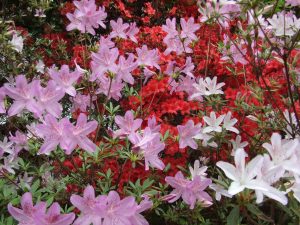 If you’re a fan of azaleas, or simply enjoy the beauty of nature, a visit to Welkinweir during the spring bloom season is an experience not to be missed. An area known as Azalea Lane in Welkinweir’s arboretum showcases many of the hybrid azaleas mentioned in this article and even more — ranging from soft pastels to vivid pinks, reds and purples — all in a breathtaking display of color.
If you’re a fan of azaleas, or simply enjoy the beauty of nature, a visit to Welkinweir during the spring bloom season is an experience not to be missed. An area known as Azalea Lane in Welkinweir’s arboretum showcases many of the hybrid azaleas mentioned in this article and even more — ranging from soft pastels to vivid pinks, reds and purples — all in a breathtaking display of color.
This collection represents one of the great booms in American azalea breeding during the 1940s to 1950s, in particular in the mid-Atlantic. The June to August summer color and intoxicating fragrance of the American azalea hybrids can best be found near the estate house on the Welkinweir grounds.
Read on to learn more about azaleas and consider adding them to your home garden.
About Azaleas

Azaleas are celebrated for their role in springtime displays, transforming the landscape into a riot of vibrant color. Popular for their striking beauty, azaleas are widely grown in gardens and landscapes around the world. Their abundant, vivid colored flowers are eye-catching, whether a single plant or a grouping of plants. They are simply gloriously gorgeous!
The blooming season of azaleas in the Brandywine Valley typically runs from late April to early May, with peak bloom occurring around Mother’s Day. So, plan your visits to azalea destinations and bloom times in your garden accordingly.
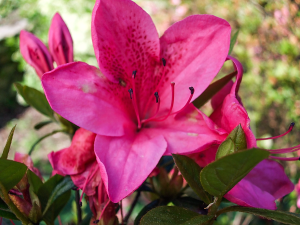
While all azaleas are technically “rhododendrons,” the opposite is not true. Azaleas differ from rhododendrons, as azaleas have smaller, thinner, fuzzy leaves lacking scales on the leaf bottom. Azaleas can be evergreen or deciduous, have habits from ground-hugging to spreading, upright, open or bushy, but it’s their showy, trumpet-shaped flowers in vibrant hues that find them a prized place in our gardens.
Hybrid azaleas are the most widely available variety, with different flowering times: early, mid-season, late and yes, even repeat bloomers. There are literally thousands of named (and unnamed) hybrid azaleas to choose from and enjoy.
Hybrids and Hybridizers
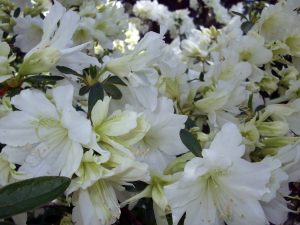
With so many hybrids available, selecting azaleas for your garden can be challenging. Azalea hybrids are often grouped by the name of the person who created them. For example, well-known varieties — Aromi, Kehr, Gable — were all developed for specific characteristics such as bloom time, flower size, growth habit or hardiness. Many of the best-known hybrid groups are well represented at public gardens in the Brandywine Valley.
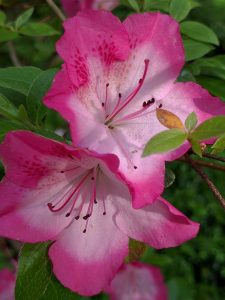
In the early to mid-season bloom category, one of the best-known groups is the Glenn Dale hybrids, developed by Ben Morrison at the U.S. Plant Introduction Station in Glenn Dale, MD in the 1940s. Morrison wanted to create a group of hardy, evergreen azaleas with large flowers. Popular Glenn Dales include the clear pink Dayspring, white Glacier, pink Aphrodite and Martha Hitchcock, sporting frilly white with a magenta-purple edge. The Glenn Dales generally mature into large plants, 6 to 8 feet tall and 3 to 4 feet wide.
Kurume azaleas are one of the oldest groups of hybrid evergreen azaleas, originating in Japan in the mid-1800s and imported to the U.S. in 1918. They bloom from early to mid-season and have good cold hardiness, with brightly colored, small to medium flowers. Flowering before the new growth, the entire plant appears covered in flowers! Sherwood Orchid, a pinkish-purple with deep color throat, is one of the most popular. And Koromo Shikibu is a unique azalea, known as the purple spider azalea for its strappy purple-pink flowers.

In mid-season, the Gable hybrids, developed by Pennsylvania nurseryman Joseph Gable, begin blooming. Gable’s azaleas came to public prominence when profiled in a March 1954 Saturday Evening Post article that featured his farm. The Big Joe is very hardy with showy trusses of pink flowers, while the intense, bright orange-red flowers of Stewartstonian complement the mahogany-color new growth.
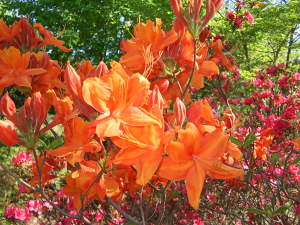
The Ghent-Knaphill-Exbury hybrid deciduous azaleas bloom in mid-season and lose their leaves in the fall. Nurserymen in Ghent, Belgium (1825) crossed native American azaleas with the European yellow azalea. Sweet-scented Narcissiflora, a bright, double-flowered yellow, is a Ghent. England’s Knaphill Nursery (1880) incorporated the California native western azalea, Japanese and Chinese azaleas into the breeding, while Lionel de Rothschild in Exbury, England worked from the 1920s to 1940s to improve these hybrids, creating the show-stopping Exbury azaleas. Two of the best-known and widely available Exburys are Gibraltor (bright orange) and Klondyke (golden yellow).
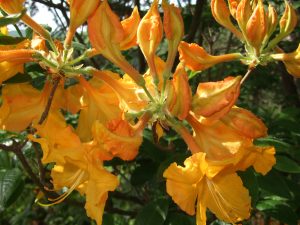
Robin Hill azaleas, developed by Robert Gartrell in Wycoff, NJ (1950–70), are relatively small to medium in size, 3 to 4 feet high, hardy with evergreen foliage, and very large flowers (up to 4 inches) blooming later, generally from mid to late May through June. Robin Hill Nancy has beautiful baby pink flowers, while Robin Hill Gillie has salmon pink blooms.
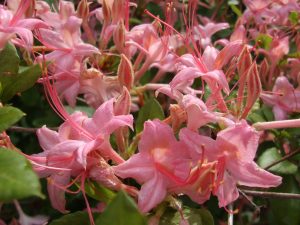
There are also a growing number of American azalea hybrids, hybridizing native deciduous species to create plants with large flowers of heavy substance, bright colors, fragrance and adaptability to specific growing conditions. Weston Nurseries Summer Series azaleas bloom from June to September in a wide range of colors, many with strong fragrance. Popsicle (June), Weston’s Parade (July) and Pennsylvania (August) offer color and fragrance beyond the typical azalea season.
Best Growing Conditions
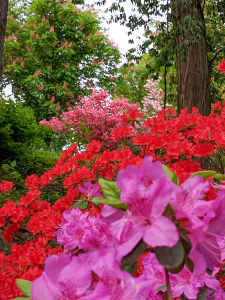
To find the best spot in your garden for azaleas, find a spot with high shade (from a canopy of trees) and slightly acidic (pH 5.5–6.0), moist but well-drained soil. Azaleas have shallow root systems that are best protected by complementary perennial groundcovers (plants such as tiarella, gingers, ferns and sweet box). A protective cover of organic mulch (oak leaves, pine straw) is also beneficial. This habitat of layers of growing plants (canopy, understory, shrub and herbaceous) mimic a healthy woodland where azaleas and related plants thrive, also creating shelter for a variety of wildlife.
To see a prime example of a thriving habitat, visit Azalea Lane at Welkinweir, which is also an excellent spot for birding.
Welkinweir is a 224-acre arboretum and nature preserve, where history, horticulture and habitat meet. Located in East Nantmeal Township, 1368 Prizer Rd., Pottstown, Welkinweir is free and open Monday to Friday, 9 a.m. to 4:30 p.m. 610-469-7543; Welkinweir.org.
Our Favorite Resources
- B&D Builders
- Ball & Ball
- Berk Hathaway Holly Gross
- Berk Hathaway Kit Anstey
- Berk Hathaway M. Schwartz
- Canvas Valley Forge
- Dewson Construction
- DiSabatino Landscaping
- King Construction
- McComsey Builders
- Monument/Sotheby’s Int’l
- Mostardi Nursery
- Mountaintop Construction
- Renewal Dynamics
- Sheller Energy
- White Horse Construction
